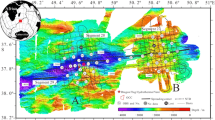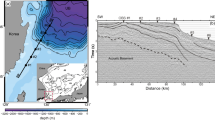Abstract
The recent (2011) installation of seismic station Zemlya Franca-Iocifa (ZFI) on Alexander Island in the Franz Josef Land Archipelago allows new seismic monitoring of the “continent-ocean” transition zone of the Barents-Kara Sea region. The region is seismically active, and we hypothesize that the prevailing geodynamic factor responsible for the occurrence of weak earthquakes is isostatic compensation of avalanche sedimentation in the “continent-ocean” transition zone. The crustal velocity structure beneath ZFI was determined using receiver functions. Crustal thickness is 30 km, based on an observed Moho discontinuity with underlying mantle velocities being Vp = 8.15 km/s and Vs = 4.5 km/s The model indicates a mid-crustal boundary at a depth of about 17 km with a velocity contrast between the upper (Vp = 6.1 km/s, Vs = 3.6 km/s) and lower (Vp = 6.8 km/s, Vs = 3.9 km/s) layers. In addition, the upper crustal sedimentary layer is about 4 km thick with Vp = 4.3 km/s and Vs = 2.36 km/s.







Similar content being viewed by others
References
Avetisov G (1996) Seismically active zones of the Arctic. Saint-Petersburg: VNIIOkeangeologia. 186 pp
Avetisov G, Bulin N (1974) Deep structure of the Franz-Josef Land on the seismological data. Geophys Methods Explor Arctic 9:26–32
Antonovskaya G, Danilov K, Konechnaya Y, Danilov A (2011) Installation and first results of the seismic station ZFI on the Franz-Joseph Land archipelago. Phys Bull Inst Nat Sci Biomed NARFU 10:31–38
Assinovskaya B (1994) Seismicity of the Barents Sea. Russian Academy of Science, Moscow, p 128
Atlas: geology and mineral resources of the shelf of Russia (2004) Moscow: Scientific world, 108 pp
Baturin D (1988) Structure and evolution of the continental margin of the Eurasian basin between Svalbard and Franz-Josef Land archipelagos. Rep Acad Sci USSR 299:412–423
Birch F (1961) The velocity of compressional waves in rocks in 10 kilobars, part 2. J Geophys Res 66(7):2199–2224
Dibner V (1978) The morphological structure of the Barents Sea shelf 211
Gabsatarova I (2006) Introduction into routine practice divisions of the Geophysical Survey of RAS calculation procedure of the local magnitude. In: Modern methods of processing and interpretation of seismic data, Geophysical Survey, Saint-Peterburg, 2–6 October, 49–53
GEOFON. GEOFON program. www.geofon.gfz-potsdam.de/geofon
Geophysical Survey of Russian Academy of Science. http://www.ceme.gsras.ru
Haskell NA (1962) Crustal reflection of plane P and SV waves. J Geophys Res 67(12):4751–4767
Hjelstuen B, Eldholm O, Faleide J (2007) Recurrent Pleistocene mega-failures on the SW Barents Sea margin. Earth Planet Sci Lett 258(4–3):605–618
International Registry of Seismograph Stations maintained jointly by International Seismological Centre & World Data Center for Seismology. http://www.isc.ac.uk/cgi-bin/stations?listc=Z
Khain V (2001) Tectonics of continents and oceans. Scientific world, Moscow, p 606
Khutorskoi M, Leonov Y, Ermakov A, Ahmedzyanov V (2009) Anomalous heat flow and the nature of troughs in the Northern part of the Svalbard plate. Rep Russian Acad Sci 424(2):227–233
Kosarev GL, Makeyeva LI, Vinnik LP (1987) Inversion of teleseismic P-wave particle motions for crustal structure in Fennoscandia. Phys Earth Planet Inter 47:11–24
Kremenetskaya E, Asming V (2002) Problems of regional seismic event location and depth estimation in the European Arctic. In: Workshop on IMS Location Calibration and Screening 4, Oslo, Norway
Kremenetskaya E, Asming V, Vinogradov Yu (2004) Seismic profiling and calibration of seismic travel-time models for Barents region. Geophysical Research Abstracts, V.6, 00881, 2004. SRef-ID: 1607-7962/gra/EGU04-A-00881 c European Geosciences Union 2004
Milanovskii E (1996) Geology of Russia and CIS countries (North Eurasia). Moscow State University, Moscow, p 448
Moroz E, Mazarovich A, Abramova A, Efimov V, Zaraiskaya Y, Sokolov S (2010) Neotectonics of the North-West of the Barents Sea. Geol Geoecol Cont Margins Eurasia 2:161–173
Morozov A, Konechnaya Y (2013) Monitoring of the Arctic region: contribution of the Arkhangelsk seismic network. J Seismol 17(2):819–827
National Oceanic and Atmospheric Administration. http://www.ngdc.noaa.gov/
Panasenko G (1986) Problems of seismic zoning of the western sector of Soviet Arctic. Nat Econ North 14:4–6
Peterson J (1993) Observations and modeling of seismic background noise. US Geol Surv Open-File Rep 93322:95
Pogrebickii Yu (1984) Transitional zones “continent-ocean” in geodynamic system of the Arctic ocean. Reports of 27th MGK 7: 29–37
Sakoulina T, Telegin A, Tichonova I et al (2000) The results of deep seismic investigations on geotraverse in the Barents Sea from Kola peninsula to Franz-Joseph Land. Tectonophysics 329(1–4):319–331
Seismic Handler - seismic waveform analysis tool. http://www.seismic-handler.org
Tikhonov A, Glasko V (1965) Use of the regularization method in non-linear problems. USSR Comput Math Math Phys 5(3):93–107
Vaganova N, Afonin N (2012) The first results on crustal and upper mantle velocity structure from receiver functions - KLM seismic broadband station in the North of Russian Plate. In: Book of abstracts 33rd General Assembly of the European Seismological Commission (GA ESC 2012), 19 – 24 August 2012, Moscow and Young Seismologist Training Course (YSTC 2012), 25 – 30 August 2012, Obninsk, pp. 74
Vanneste M, Mienert J, Bunz S (2006) The Hinlopen slide: a giant, submarine slope failure on the northern Svalbard margin, Arctic Ocean. Rep Earth Planet Sci Lett 245(1–2):373–388
Verba M (2007) Modern bilateral tension of the earth’s crust in the Barents-Kara region and its role in the evaluation of the hydrocarbon potential. Oil and gas Geology. Theory and practice, 2, http://www.ngtp.ru/rub/4/026.pdf
Vinnik L (1977) Detection of waves converted from P to S in the mantle. Phys Earth Planet Inter 15(1):39–45
Vinogradov A, Baranov S (2013) The possible impact of landslide processes on the seismicity of the north-western part of the Barents sea. In: Modern methods of processing and interpretation of seismic data, Geophysical Survey, Gelendzghik, 99–103
Winkelmann D, Stein R (2007) Triggering of the Hinlopen/Yermak Megaslide in relation to paleoceanography and climate history of the continental margin north of Spitsbergen. Reports of Geochem.Geophys. Geosyst. (G3), V. 8, 6, 1–15. (An electronic journal of the earth sciences doi:10.1029/2006GC001485)
Yudahin F, Francuzova V (2006) The need to create a network of seismic monitoring in the northern regions of Russia. Vestnik Ural Branch Russ Acad Sci 2(16):25–35
Zaionchek AV, Brekke H, Sokolov SYU, Mazarovich AO, Dobrolyubova KO, Efimov VN, Abramova AS, Zaraiskaya YUA, Kohan AV, Moroz EA, Peive AA, Chamov NP, Yampolskiy KP (2010) The structure of the transition zone continent-ocean north-western periphery of the Barents Sea (according to 24, 25 and 26 flights vessel “Akademik Nikolai Strakhov,” 2006-2009). The structure and evolution of the lithosphere. Russia’s contribution to the International Polar Year, Moscow, Paulsen, 4:111–157
Acknowledgments
The authors would like to thank Kevin G. Mackey of the Michigan State University and Sergey Y. Sokolov of the Geological Institute of Russian Academy of Sciences for their suggestions in the research.
Author information
Authors and Affiliations
Corresponding author
Rights and permissions
About this article
Cite this article
Morozov, A.N., Vaganova, N.V., Konechnaya, Y.V. et al. New data about seismicity and crustal velocity structure of the “continent-ocean” transition zone of the Barents-Kara region in the Arctic. J Seismol 19, 219–230 (2015). https://doi.org/10.1007/s10950-014-9462-z
Received:
Accepted:
Published:
Issue Date:
DOI: https://doi.org/10.1007/s10950-014-9462-z




